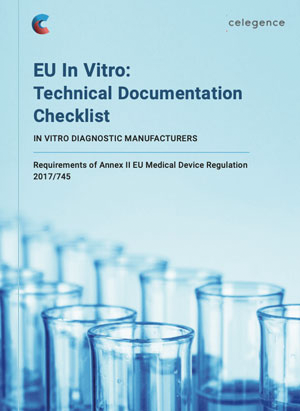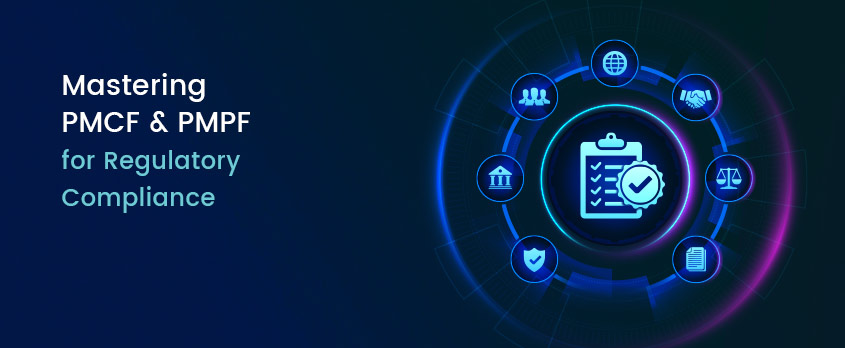
Understanding Post-Market Clinical Follow-up (PMCF)
Post-Market Clinical Follow-up (PMCF) is a specific type of post-market surveillance (PMS) activity that involves collecting clinical data after a medical device has been placed on the market. This data helps assess the device’s long-term safety and effectiveness in real-world use.
The Role of Post-Market Performance Follow-up (PMPF) in IVDR
Post-Market Performance Follow-up (PMPF) is a broader concept under the In Vitro Diagnostics Regulation (IVDR) that encompasses the continuous monitoring and evaluation of an In Vitro Diagnostic (IVD) device’s performance throughout its lifecycle.
Objectives of PMCF and PMPF: Both PMCF and PMPF aim to ensure the device’s continued performance meets its intended purpose and the benefit-risk profile remains acceptable.
Strategy for Drafting PMCF & PMPF Plans and Reports
- Define Objectives: Clearly articulate the specific aims of the PMCF/PMPF plan. Detail which safety and performance aspects of the device will be monitored.
- Identify Data Sources: Specify the origins of data to be gathered, such as clinical trial results, registries, complaints, and feedback from healthcare providers.
- Data Collection Methods: Establish a robust framework for collecting and analysing data to ensure its integrity and traceability.
- Risk Assessment: Continually evaluate risks identified during pre-market assessment and any emerging risks using post-market data with ongoing risk management.
- Periodic Reporting: Regularly compile reports summarizing collected data, trends identified, and any corrective measures deemed necessary.
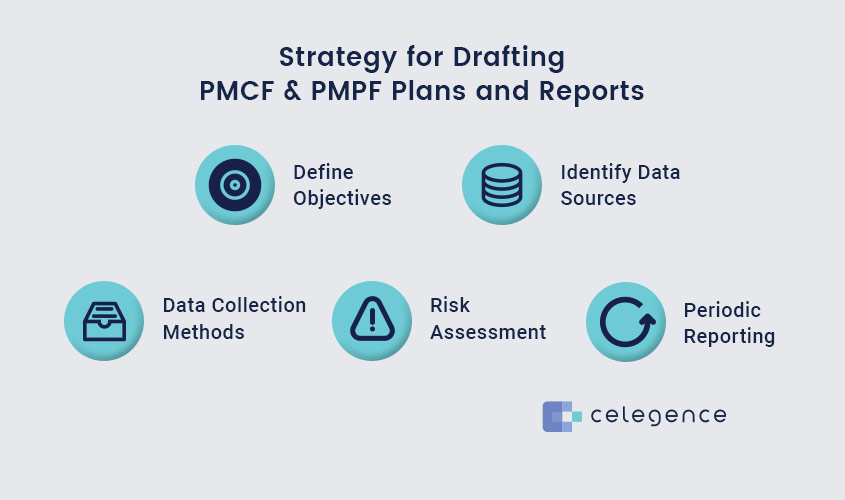
Methods for Conducting Post-Market Clinical Follow-up (PMCF) and Post-Market Performance Follow-up (PMPF) Studies
- General Methods
General methods for assessing the performance of a medical device in real-world-use involve gathering information from various sources. Here are some examples:
Clinical Experience: This involves collecting data on the device’s performance in clinical practice. Methods include retrospective or prospective chart reviews of patients who have used or have been treated using procedures where the device was in use.
Scientific Literature Review: Reviewing published studies and conducting systematic literature reviews on the device can help identify emerging safety or performance issues.
- Specific Methods for PMCF
PMCF studies and surveys focus specifically on collecting clinical data, so let’s delve into those methods.
User Feedback: Insights from healthcare providers and patients who use the device are valuable for evaluating its performance. This feedback can be obtained through surveys, focus groups, and complaint-reporting systems.
New Interventional Studies: These can be designed in various ways, including:
- Registries: Collecting data from a specific patient population using the device.
- Patient Reported Outcomes: Using surveys or questionnaires to gather information directly from patients about their experience with the device.
- Physician-Reported Outcomes: Data are collected from healthcare providers on their observations of the device’s effectiveness and safety in their patients.
- Specific Methods – PMPF
Ring Trials: Controlled studies where a group of healthcare providers use the device in a specific setting and report on their experiences.
Epidemiological Studies: Assessing the long-term safety and effectiveness of a device in a large population.
Quality Assurance Activities: Utilizing existing quality assurance programs to collect data on device performance, including information on adverse events, complaints, and malfunctions.
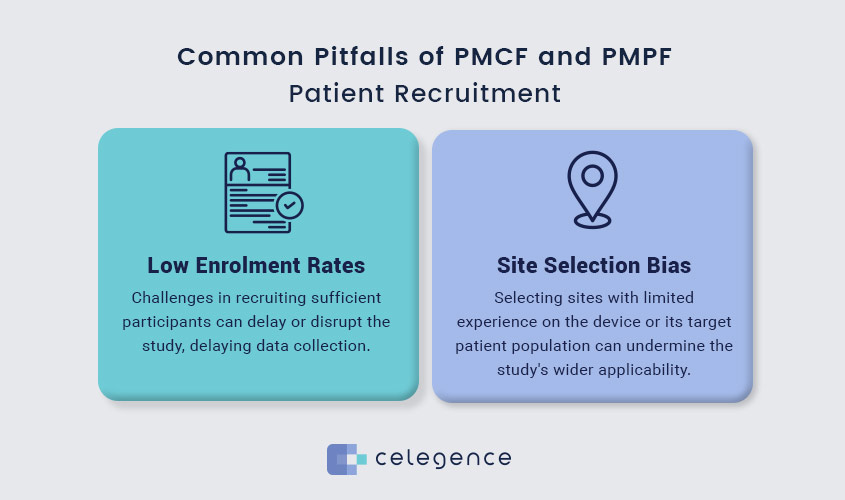
Common Pitfalls of PMCF and PMPF
- Misinterpretation Observed with PMCF, PMPF, and PMS
PMCF and PMPF are distinct activities within the broader PMS system. Some manufacturers might erroneously consider them interchangeable, resulting in an incomplete PMS plan.
- Study Design
Unrealistic Objectives: PMCF studies must have well-defined, achievable objectives that align with the device’s risk profile. Setting overly ambitious goals can lead to wasted resources and inconclusive data.
Poor Methodology: Selecting an inappropriate study design, such as using retrospective analysis when prospective data is required, can hinder the ability to draw meaningful conclusions regarding the device’s performance.
- Study Subjects
Limited Patient Pool: The study population may not accurately represent real-world usage, potentially overlooking important safety signals from specific patient subgroups.
Ethical Considerations: Neglecting to adequately address ethical considerations and obtain informed consent from participants can lead to regulatory issues.
- Patient Recruitment
Low Enrolment Rates: Challenges in recruiting sufficient participants can delay or disrupt the study, delaying data collection.
Site Selection Bias: Selecting sites with limited experience on the device or its target patient population can undermine the study’s wider applicability.
- Unclear Risk Assessment and PMCF Objectives
Failing to clearly communicate the device’s risk profile and the rationale behind the chosen PMCF/PMPF plan can raise questions from Notified Bodies.
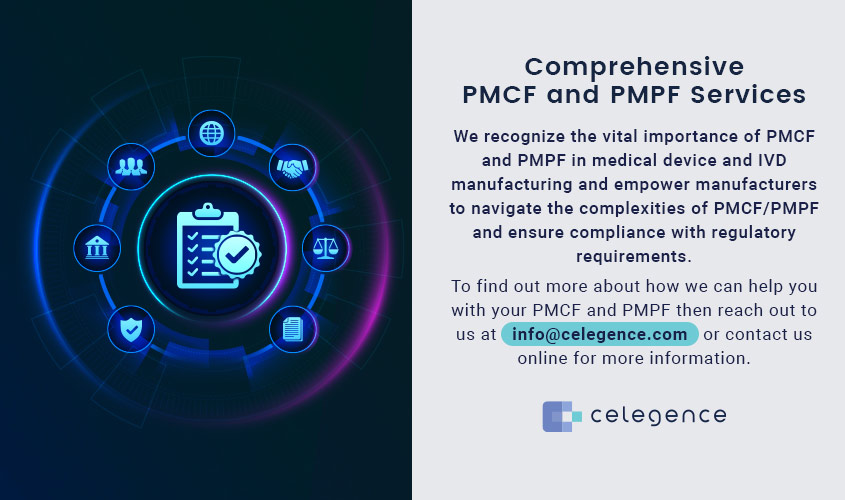
Comprehensive PMCF and PMPF Services
At Celegence, we recognize the vital importance of PMCF and PMPF in medical device and IVD manufacturing. As a specialized regulatory services company, we empower manufacturers to navigate the complexities of PMCF/PMPF and ensure compliance with regulatory requirements. Our comprehensive suite of services related to post-market activities, offers value through:
- Strategic Planning and Gap Analysis
- Draft Plan & Report Preparation
- Data Management and Reporting
- Regulatory Liaison and Communication
- Quality Management System Integration
Our expertise helps you navigate the intricacies of post-market activities, allowing manufacturers to concentrate on patient safety and continuous product improvement.
To find out more about how we can help you with your PMCF and PMPF then reach out to us at info@celegence.com or contact us online for more information.
References
The checklist highlights all of the documentation that you will need in place for certification of your IVD device and will serve as a guide to help you achieve ongoing compliance. In conjunction with this checklist, we are also able to provide you with bespoke strategies to bring your business up to speed. We are currently working with businesses from the United States, India, and throughout Europe to ensure that they are ready for the deadline in May of 2022.
About The Author

This blog was authored by Prasad Ravichandran, a Team Lead in Medical Device Regulatory Affairs at Celegence. Prasad is a Certified Lead Auditor for ISO 13485:2016, with extensive experience in medical devices and IVD technical documentation submission, CDSCO registration, and securing wholesale and import licenses. He is also an experienced clinical research auditor.
